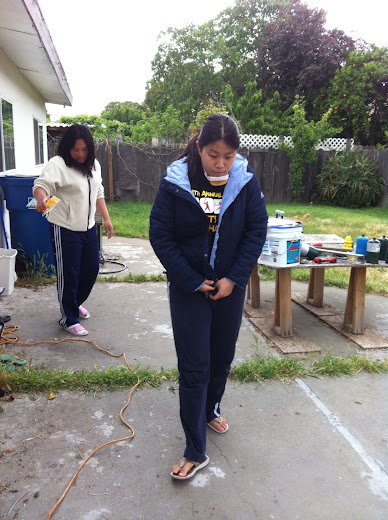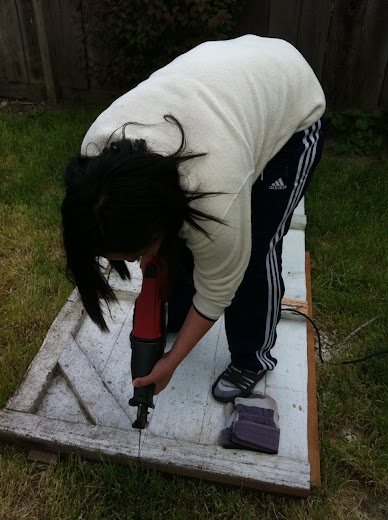Some of you know that my sister, her roommate, Tina, and me, are building a sustainable garden in their backyard. Our first step is to make raised bed planters; high enough to keep Gucci out (beloved Siberian Husky), as well as height proportionate to avoid unnecessary bending. Fortunately, due to a recent garage door replacement we have plenty of wood.
By re-purposing Tina's old garage door, she saved $50 from not having to discard it--saved it from ending up in a landfill--and we felt good for being environmentally conscience. Being green really does feel good.
We laid 2x4s for the door to float on for easier cutting. Teardrop (my Jack) checked our work.
Tina layered clothing for the project; for the cold and to create a thicker barrier from a possible explosion. Mind you, none of us had ever used a power handsaw, let alone built something using a relative of the "saw" family, so the concern of a flying blade or exploding hand tool was in the back of our minds. The fact she's wearing flip flops (we all were) and lacks protective goggles is a good indication that we've never done this. Lol.
We laid the door on the 2x4s. All I can say is, that door was HEAVY...I mean "need three guys" kind of heavy. But we were determined and made it happen, luckily no one lost their toes. Hehe. Oh, and my sister did her victory dance.
So now we think we're ready to saw away. Umm...so who knows how to work this thing? Where's the instruction manual?
My sister's convinced she can figure it out without the manual...
We were about to pry her fingers off the handsaw but she figured it out. Beginner's luck. Lol.
And my sister does another victory dance while Tina begins to cut.
We hit a roadblock and several of them--nails! So we had to unnail the big guy before our second attempt at cutting.
Once we finished unnailing, we cut through the door for our first planter piece. Yay! We left the support beams intact since they held the door together.
Next, we cut the piece in half (vertically).
We measured one of the halves to make ends.
As the saying goes, "Measure twice before you cut." We measured four times.
Our first "end"! Tina's ready to pre-hole drill this sucker.
We were starting to see the planter come together, and still no lost toes!
It was dusk by the time we attached the second end. We were tired but couldn't stop; too close to achieving the vision.
We're smiling because we're almost done! Thank God!
We're done, we're done!
This took us one late afternoon and evening (approximately 6 hours). We're planning to build two more planters starting this Sunday, the 30th. They should go faster since we learned a lot from the first trial. I have to say, it was very rewarding to work until we reached our final result. Wohoo!
Also, just wanted to confirm that I did help throughout the project, but as the picture-taker, I luckily got out of being in the pictures, even though it made me look like a slacker. :-p

















































